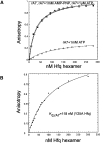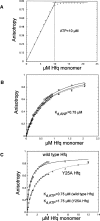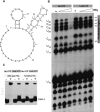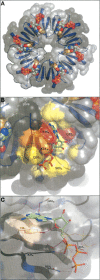Sm-like protein Hfq: location of the ATP-binding site and the effect of ATP on Hfq-- RNA complexes
- PMID: 17660259
- PMCID: PMC2206964
- DOI: 10.1110/ps.072883707
Sm-like protein Hfq: location of the ATP-binding site and the effect of ATP on Hfq-- RNA complexes
Abstract
Sm-like proteins are ubiquitous ring-shaped oligomers that exhibit a variety of nucleic acid-binding activities. They have been linked functionally to various cellular events involving RNA, and it is generally believed that their activity is exerted via the passive binding of nucleic acids. Our earlier studies of the Sm-like Escherichia coli protein Hfq provided the first evidence indicating that Hfq is an ATP-binding protein. Using a combination of biochemical and genetic techniques, we have now determined a plausible ATP-binding site in Hfq and tested Hfq's ATP-binding affinity and stoichiometry. The results of RNA footprinting and binding analyses suggest that ATP binding by the Hfq-RNA complex results in its significant destabilization. RNA footprinting indicates deprotection of Hfq-bound RNA tracts in the presence of ATP, suggestive of their release by the protein. The results reported herein broaden the scope of potential in vivo roles for Hfq and other Sm-like proteins.
Figures







Similar articles
-
Structural and biochemical studies on ATP binding and hydrolysis by the Escherichia coli RNA chaperone Hfq.PLoS One. 2012;7(11):e50892. doi: 10.1371/journal.pone.0050892. Epub 2012 Nov 30. PLoS One. 2012. PMID: 23226421 Free PMC article.
-
Computational approach to ensure the stability of the favorable ATP binding site in E. coli Hfq.J Mol Graph Model. 2010 Dec;29(4):573-80. doi: 10.1016/j.jmgm.2010.11.003. Epub 2010 Nov 11. J Mol Graph Model. 2010. PMID: 21134774
-
Escherichia coli Hfq binds A18 and DsrA domain II with similar 2:1 Hfq6/RNA stoichiometry using different surface sites.Biochemistry. 2006 Apr 18;45(15):4875-87. doi: 10.1021/bi0523613. Biochemistry. 2006. PMID: 16605255
-
The bacterial Sm-like protein Hfq: a key player in RNA transactions.Mol Microbiol. 2004 Mar;51(6):1525-33. doi: 10.1111/j.1365-2958.2003.03935.x. Mol Microbiol. 2004. PMID: 15009882 Review.
-
Hfq structure, function and ligand binding.Curr Opin Microbiol. 2007 Apr;10(2):125-33. doi: 10.1016/j.mib.2007.03.015. Epub 2007 Mar 28. Curr Opin Microbiol. 2007. PMID: 17395525 Review.
Cited by
-
Structural and biochemical studies on ATP binding and hydrolysis by the Escherichia coli RNA chaperone Hfq.PLoS One. 2012;7(11):e50892. doi: 10.1371/journal.pone.0050892. Epub 2012 Nov 30. PLoS One. 2012. PMID: 23226421 Free PMC article.
-
Defining a role for Hfq in Gram-positive bacteria: evidence for Hfq-dependent antisense regulation in Listeria monocytogenes.Nucleic Acids Res. 2010 Jan;38(3):907-19. doi: 10.1093/nar/gkp1081. Epub 2009 Nov 26. Nucleic Acids Res. 2010. PMID: 19942685 Free PMC article.
-
Cooperation of Escherichia coli Hfq hexamers in DsrA binding.Genes Dev. 2011 Oct 1;25(19):2106-17. doi: 10.1101/gad.16746011. Genes Dev. 2011. PMID: 21979921 Free PMC article.
-
Amyloid-like DNA bridging: a new mode of DNA shaping.Nucleic Acids Res. 2025 Feb 27;53(5):gkaf169. doi: 10.1093/nar/gkaf169. Nucleic Acids Res. 2025. PMID: 40066879 Free PMC article.
-
An introduction to biomolecular graphics.PLoS Comput Biol. 2010 Aug 26;6(8):e1000918. doi: 10.1371/journal.pcbi.1000918. PLoS Comput Biol. 2010. PMID: 20865174 Free PMC article. No abstract available.
References
-
- Arluison V., Derreumaux, P., Allemand, F., Folichon, M., Hajnsdorf, E., and Régnier, P. 2002. Structural modeling of the Sm-like protein Hfq from Escherichia coli . J. Mol. Biol. 320 705–712. - PubMed
-
- Arluison V., Mura, C., Guzman, M.R., Liquier, J., Pellegrini, O., Gingery, M., Regnier, P., and Marco, S. 2006. Three-dimensional structures of fibrillar Sm proteins: Hfq and other Sm-like proteins. J. Mol. Biol. 356 86–96. - PubMed
-
- Azam T.A., Hiraga, S., and Ishihama, A. 2000. Two types of localization of the DNA-binding proteins within the Escherichia coli nucleoid. Genes Cells 5 613–626. - PubMed
-
- DuBow M.S., Ryan, T., Young, R.A., and Blumenthal, T. 1977. Host factor for coliphage Q β RNA replication: Presence in procaryotes and association with the 30S ribosomal subunit in Escherichia coli . Mol. Gen. Genet. 153 39–43. - PubMed
Publication types
MeSH terms
Substances
LinkOut - more resources
Full Text Sources
Molecular Biology Databases

